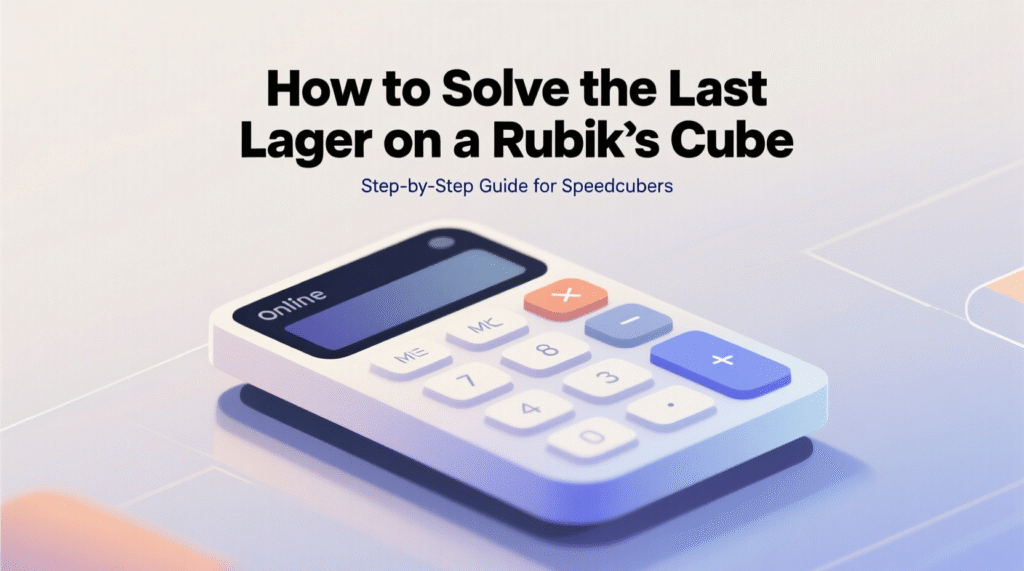
Solving the last layer of the Rubik’s Cube is the step that intimidates most people. You’ve got the first two layers complete, but the top face looks scrambled and messy. This is where many cubers get stuck.
The good news: you don’t need to learn 78 algorithms right away. With the 2-Look OLL and 2-Look PLL methods, you can break the last layer into manageable steps, solve it consistently, and start moving toward faster times.
What Does “Last Layer” Mean?
The last layer is the top side of the cube. To solve it, you need to:
- Orient pieces – make the top face all one color.
- Permute pieces – put those oriented pieces in the right spots.
This is where OLL (Orientation of the Last Layer) and PLL (Permutation of the Last Layer) come in.
- Full OLL + PLL: 78 algorithms in total, used by advanced speedcubers.
- 2-Look OLL + PLL: Just 9–10 algorithms, perfect for intermediates.
Step 1: Make the Last Layer Cross (Edge Orientation)
Check the top layer:
- Dot (no yellow edges) → Do F R U R’ U’ F’.
- “L” shape → Hold it in the top left corner and repeat the same alg.
- Line → Hold it horizontally and repeat.
Once done, you’ll see a yellow cross on the top face.
Step 2: Turn the Top Face All Yellow (Corner Orientation)
Now orient the yellow corners so the whole top face becomes solid.
Useful algorithm:
R U2 R2 U’ R2 U’ R2 U2 R
Repeat until all the corners turn yellow.
Use: easy online cube solving tool
Step 3: Put Corners in the Right Spots (Corner Permutation)
Even if the top is all yellow, corners may be in the wrong places.
- If one corner is correct, hold it at the front right and use:
U R U’ L’ U R’ U’ L
Repeat until all corners are in the correct positions.
Step 4: Position the Edges (Edge Permutation)
Now swap the edges into the correct places.
- Clockwise cycle → F2 U L R’ F2 L’ R U F2
- Counterclockwise cycle → Same algorithm mirrored.
And just like that, your cube is solved.
Full OLL vs 2-Look: Which Should You Learn?
| Method | Algorithms to Learn | Solve Speed | Best For |
|---|---|---|---|
| 2-Look OLL/PLL | 9–10 | 30–60 sec | Intermediates |
| Full OLL/PLL | 78 | Sub-15 sec | Advanced speedcubers |
Most solvers start with 2-Look, then gradually add more algorithms.
Practice Drills for Faster Last Layer Solving
- Slow solves: Focus on recognition, not speed.
- Case training: Scramble the cube to practice specific OLL or PLL cases.
- Timers: Use apps like CS Timer to measure Ao5 (average of 5) and Ao12 (average of 12).
- Visual tools: Try an interactive Rubik’s Cube solver or a scrambler and solver tool to generate cases and follow step-by-step solutions.
Common Mistakes
- Holding the cube the wrong way before starting an algorithm.
- Over-rotating instead of using finger tricks.
- Forgetting that algorithms may need repeating depending on the case.
FAQs: Solving the Last Layer
Q: What’s the easiest way to solve the last layer?
Use 2-Look OLL and PLL. It’s simpler and gets you solving consistently without learning dozens of algorithms.
Q: How many algorithms do I need for 2-Look?
Around 9–10, compared to 78 for full OLL/PLL.
Q: Should I learn full PLL as an intermediate solver?
Not immediately. Master 2-Look first, then add PLL cases one by one.
Q: How can I recognize last-layer cases faster?
Look for “headlights” (two same-color stickers side by side) or unique line/shape patterns. With practice, recognition becomes automatic.
Q: Can I solve the last layer without memorizing algorithms?
Yes, but it’s slower. Algorithms are shortcuts that reduce move count and time.
